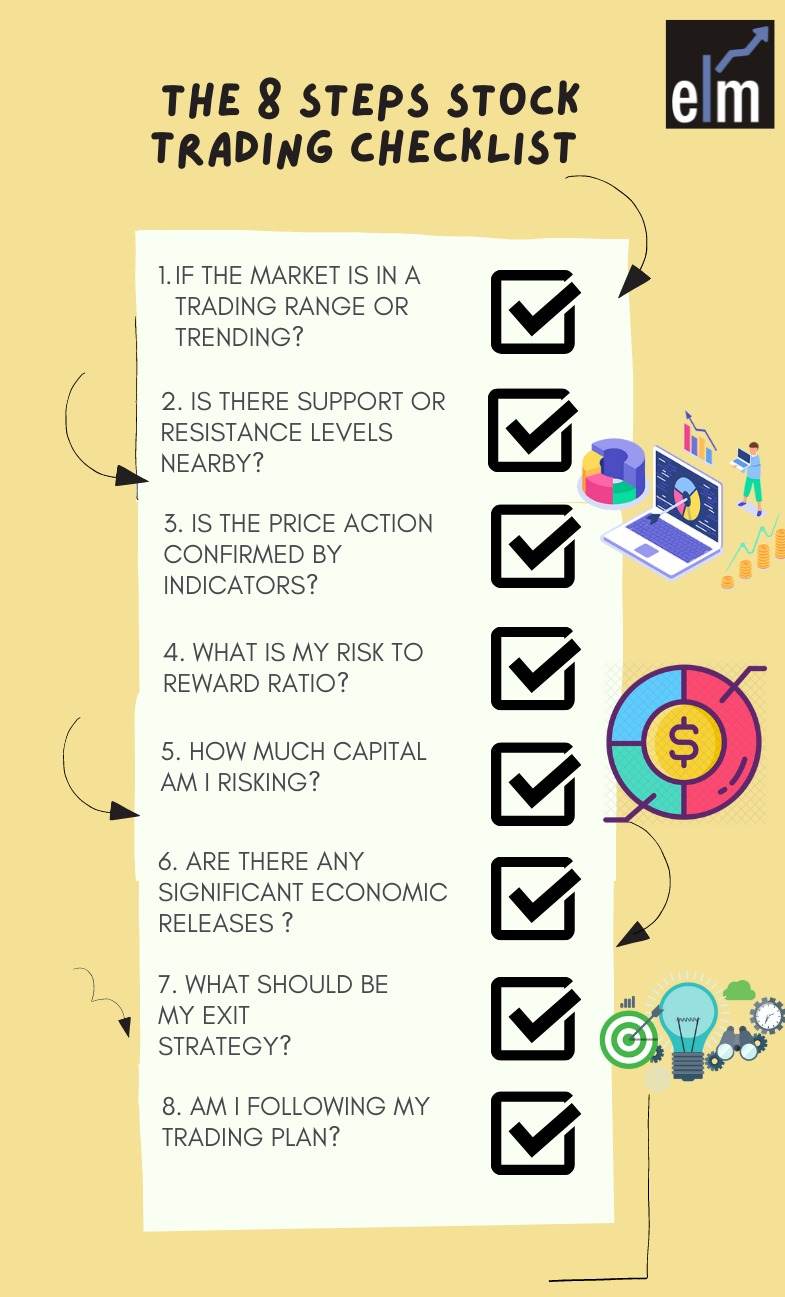Do you know that you should have a stock trading checklist before you enter any trade? Yes! One needs to have a proper checklist before entering any trade as it helps traders stay disciplined, stick to the trading plan, and build confidence.
One should remember that a good start is half the battle won! Thus maintaining a trading checklist can help the traders with a list of questions that they need to answer before executing any trades.
But wait! We mustn’t confuse a plan with a checklist. The trading plan refers to a bigger picture, such as deciding the market you want to trade and the analytical approach you choose to follow. The checklist, on the other hand, focuses on each trade and also the conditions which should be met before the trade order is executed.
So today in this blog we will be discussing 8 steps for making a Stock Trading Checklist that you should check before executing any orders:

1. If the market is in a trading range or trending?
Experienced traders should know that when a stock is in a strong trend and trading in the direction of the trend can lead to a higher probability of right trades. There is a well-known saying that the trend is your best friend. As we can see from the below chart, when we trade along the ongoing trend we can earn profits:
Traders need to ask themselves if the prices of the stock are in a strong trend and whether they want to trade along with the trend as a part of their trading plan.
Whereas a stock is in a range bound when the prices of that stock bounce between support and resistance and trade within a channel as shown below:
Certain stocks tend to trade in ranges. One can use oscillating indicators such as RSI, CCI and Stochastics for trading in the ranging markets. So, making any trading checks whether the stock’s prices are in a trading or ranging phase and whether the trading in a range or a trending market is a part of your trading plan.
2. Is there support or resistance levels nearby?
One also needs to check whether there is any support or resistance level nearby before executing any trading order for that particular stock. Usually, the price action tends to respect particular price levels for many reasons and one must be able to identify these levels. Traders do not want to enter a long position in which there is a key level of resistance nearby only to bounce back lower.
The same applies when the price reaches a key level of support and typically bounces after. Trend traders should look for breakouts of these levels as it indicates that the market may start to trend. However, Range traders will look for prices to bounce between support and resistance for prolonged periods.
3. Is the price action confirmed by indicators?
Traders should note that the indicators help the traders in confirming high probability trades. Depending on their trading plan as well as their strategy, traders should have 2-3 indicators that complement their trading strategy. One should not make their analysis complicated by adding multiple indicators to a single chart. They should keep their analysis clean and simple and easy to view at a glance.
Also, one should not use 2-3 indicators of the same group. For example, it is always better to use volatility indicators like Bollinger bands with momentum indicators such as the Relative Strength Indicator. One should check whether these technical indicators confirm the trading signal before executing any trader order.
4. What is my risk to reward ratio?
The risk to reward ratio refers to the ratio of the number of pips that the traders are willing to risk to reach their target. Traders should have a positive risk-reward such as a 1:2 ratio that means that a trader risks half of what he stands to gain if the trade works out. So, traders must consider their risk to reward ratio before executing any trading order.
5. How much capital am I risking?
Before placing an order, one should ask themselves how much of their capital are they willing to risk for a single trade. There are times when traders use all their capital in a single trade and also start leveraging the account to the maximum when they are overconfident in one trade.
This can be avoided by limiting the part of capital used on a single trade. Also, one can set stops on all trades for ensuring that the total amount risked is no more than 5% of the account balance.
6. Are there any significant economic releases that can impact the trade?
One needs to check if there are any economic releases that can affect the price movement of the particular stock in which they are going trading. Economic releases like GDP, CPI, PMI, Autos sales numbers can drastically affect the prices of the stock or index. So, we need to keep a close watch on the economic data that are going to be released soon.
You can check the Forthcoming events from the Daily Updates section in StockEdge as shown below:
7. What should be my Exit Strategy if the prices go in the opposite direction?
Our trade can’t always be right and we may not get profits every time. Thus, we should always have a backup plan in case the prices do not go according to our expectations. For this purpose, we should always put a stop order when we enter any position so that we are safe from incurring too many losses. Stop-loss prices can be determined in many ways such as using support or resistance levels, Fibonacci levels, the low of prior candlesticks and so on. You can also read our blog on How to Place Stop Loss in Trading? For understanding how to determine the price for stop-loss orders.
8. Am I following my trading plan?
Last but not the least, before placing any trading order one should ask if this order goes along with my trading plan. One should not deviate from their trading plan as it will cause mixed results and only frustrate the trading process. Keep in mind that you should not place trades unless the trading checklist has been completed and also confirm whether the trade can be executed. Learn in details from our stock trading for beginners course
Join our stock trading course- ONLINE NSE ACADEMY CERTIFIED CAPITAL MARKET PROFESSIONAL (E-NCCMP) to learn how to trade in the stock market.
Bottomline
Above are some of the pointers that we considered important and should be kicked before entering any trade. But having a checklist does not mean that all trades will become winning trades automatically. However, It will help traders to stick to the trading plan, trade with consistency, and also avoid impulsive or reckless trades. We hope that you found this blog informative and use the information to its max potential in the practical world. Show some love by sharing this blog with your family and friends and help us in our mission of spreading financial literacy.
Happy Investing!






